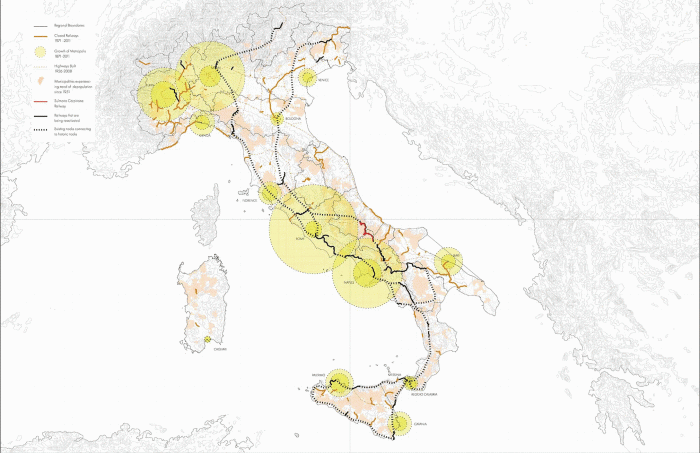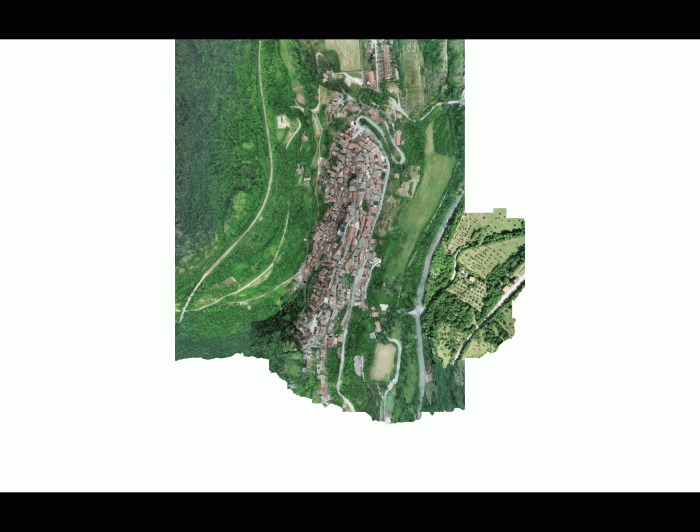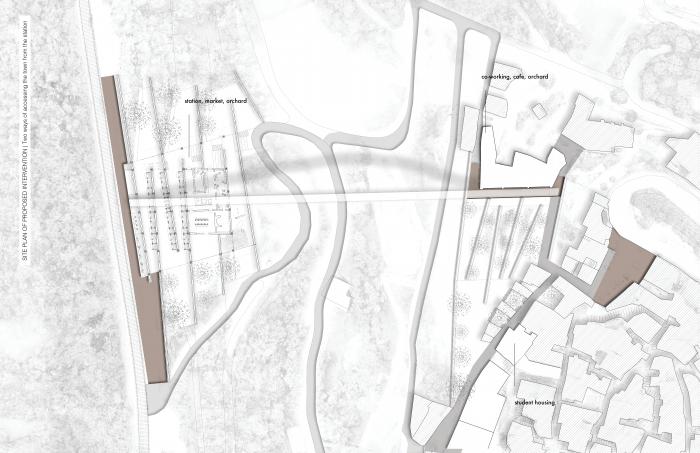Rebuilding the Edge is a mapping exercise. It is a reprogramming strategy for struggling towns along an infrastructural reinvestment project. It is also a design project for a single station along the rail that can maximize a town’s ability to capitalize on incoming economic activity. This project is only the beginning of a Liminal's research initiative in partnership with Fondazione Ferrovie dello Stato Italiane, MIT's UrbanRisk Lab and the municipality of Pettorano sul Gizio.
Rebuilding the Edge takes as its point of departure the depopulation of small centers in Italy over the last century, a social reality with a direct impact on the built environment and consequences for citizens–local and national. The project focuses on the redevelopment of the Sulmona-Carpinone rail line in the region of Abruzzo and what this means for depopulating centers along it. By studying this event at a variety of scales–national, territorial, and local–Rebuilding the Edge explores how architecture can make a contribution to issues usually tackled by non-spatial thinkers, such as politicians, policymakers and economists. In this effort, the project experiments with ways in which design can play a role in some of the most challenging issues of social cohesion that affect rural Europe.
Rebuilding the Edge is a mapping exercise. It is a reprogramming strategy for struggling towns along an infrastructural reinvestment project. It is also a design project for a single station along the rail that can maximize a town’s ability to capitalize on incoming economic activity.
This project is only the beginning of a research initiative in partnership with Fondazione Ferrovie dello Stato Italiane, and MIT's Urban Risk Lab. Liminal, a research design and consultancy group that uses a multi-disciplinary approach to tackle the challenges that lie ahead for the Italian countryside, is actively working with the community of Pettorano Sul Gizio to access governmental funding in order to repurpose the abandoned infrastructure in the town. As part of this initiative, Liminal will host a three weeks workshop with MIT students along with, Fondazione F.S. and MIT Urban Risk Lab to further vision the future of this small community.
Please highlight how the concept/idea can be exemplary in this context
Rebuilding the Edge focuses on Pettorano sul Gizio, the first town along the Sulmona-Carpinone rail where services are in the process of expansion. It proposes a new program for the town’s station and an access from the station to the town. Pettorano sul Gizio is surrounded by orchards, a river, and natural reserves. The project involved 3D scanning and mapping the whole settlement. This revealed that Pettorano has the typical formation of central mountainous Italian towns developed along the ridges of low promontories, with a tight linear street pattern that follows the steep contour lines. The roofs that have collapsed are usually on steep or narrow streets, usually along the cliffs that face the river. On the other side of the town where slopes are shallower and main access roads have been built, buildings have remained better preserved and more used. Based on the findings from the research conducted the project proposes the following:
- Reusing the existing station, which is too distant for pedestrians and currently surrounded by orchards, as a lab to study how different species react to drastic climate changes in the area, building on some other nearby towns are doing.
- Creating a new way of entering the town by adding a new station with a market facing the side of the town that has no direct access. This would revitalize the decadent edge of the town and generate a source of income for the town that is directly tied to the produce generated around the existing station.
- Creating two primary access strategies from the station and market to Pettorano: An elevated covered path that connects you directly to the town and a path along the valley and its orchards, reconnecting and repaving eroded streets. Both paths start at the station and land at a new garden that precedes the town's main access plaza.
- Along the repaved path and the garden plaza, reusing and expanding some of the collapsed buildings to host student housing for those who will work at the lab.
Please highlight how the concept/idea can be exemplary in this context
The project at the scale of Pettorano sul Gizio is principally concerned with choreographing the experience of travelers and visitors that arrive at the town, which is currently in the midst of a revival effort. It eases access to the town from the station by bridge the gulf between them, whilst offering an alternative natural path for those experiencing the place at a different pace. It aso inserts programs along the way that make local products and services visible to visitors, thus enhancing the competitiveness of the town’s entrepreneurial ecosystem.
All of this is achieved through an aesthetic and architectural strategy that seeks both to be respectful of the historic town, and premonitory of the new technologies and ways of life coming to reimagine its future. The station’s sloping site is formed through the use of traditional dry stone masonry walls that host the market and other related programs. Travelers have the option to enter, move through and exit the single roof of the station, through the paths made by this traditional element of agricultural infrastructure. For those instead that choose to take the bridge over the valley that drops them off at the town directly, a direct path is offered form the train platform that minimizes barriers for people with limited mobility. The bridge though is not a path sitting on a conventional bridge. The bridge is structured rather like a roof that blends into the towns upon which it arrives, and below which people may move through a hanging platform where they are protected from the intense summer heat, and the slippery winter snow.
Please highlight how the concept/idea can be exemplary in this context
The role of the architectural intervention in this context is one that promotes union across towns. It is crucial to think about how a large investment for one project can serve multiple municipalities. This is a difficult task since it requires extensive conversations and communal decision making, but an essential one as well in order to create a strong economic network that can survive over time. This project works in the spirit of ongoing regional initiatives like the MITO project–a joint regional planning office with the objective of thinking strategically and territorially rather than each municipality in isolation. Often, top-down investments can fuel existing tensions and rivalries amongst towns that want to benefit from funding coming through initiatives like the current EU Recovery and Resiliency Fund. However, there are services and programs that multiple stakeholders can share. The main objectives of the project focus on creating a large enough shared investment that has the capacity of achieving the following:
- Incentivizing families and young people to move to the region and the town of Pettorano sul Gizio;
- Creating better tourism infrastructure, services, and connectivity infrastructure;
- Improving the educational facilities in the area for young families; and
- Creating resiliency plans to mitigate the impacts of the climate crisis on the local environment and agricultural economy.
By creating mixed programmed shared stations along the railway, the project sets up the framework for moments of exchange, inclusion and social innovation to take place between different communities. At the architectural scale the project incentivizes the involvement of communities and the employment of local labor by implementing construction techniques, such as dry stone terracing, that are local to the region.
Please highlight how this approach can be exemplary
From an academic standpoint, this project highlights the importance of a feedback loop between urbanism, architecture and the communities involved to arrive at a shared vision for the future of a territory. Working at different scales allows this project to find different areas on which to intervene that include transforming certain structures into education facilities, remote working service and mobility infrastructures. The implementation of different tools, commonly used in isolation, allows the research to go from a broader to a more granular understanding of the potential of the railway infrastructure in revitalizing some of the internal areas of Italy and diminishing the Italian CO2 car emission, in fact italians are the highest car owner per capita in Europe.
From the perspective of practice, Rebuilding the Edge starts to point out where architecture–and more generally spatial disciplines–can contribute to the articulation and resolution of larger-scale initiatives. The project starts to explore what solutions are prototypical and which ones are specific to the researched context and town of focus.
It is also important to highlight some of the limitations of this project at this stage. Rebuilding the Edge is not a manual of work since the work of the detective is always determined by the personal inclinations of the detective herself. Although the project proposes a framework, it is not a manual that predetermines what instructions to follow to guarantee a specific result. Rebuilding the Edge explores one way to begin proposing tangible solutions to some of the initiatives undertaken in Italy today. It proposes how tools, such as GIS photogrammetry or stakeholder interviewing can provide insight that paves a path towards design solutions concerned with tangible problem-solving.
Rebuilding the Edge applies GIS mapping and photogrammetric tools to register the rural realities along an abandoned rail line in central Italy. It interprets available data at the territorial scale and generates original data more granularly through contemporary technologies. Combined with stakeholder interviews and policy framework analyses, this sets the stage to generate considerations regarding urbanism and architecture's role in this context. This is an innovative approach that breaks across distinct camps of design thinking that usually take either a participatory or data approach to problem solving. It also employs novel documentary methodologies that fill the gaps of available site information and allow for granularity generally unavailable in the field.
From a disciplinary perspective, the project proposes that architecture has a relevant role in the articulation and resolution of larger initiatives that seek to address the challenges faced by towns across Italy. It does not attempt for architecture to act as a 'savior,' but rather concludes that architecture must operate in the company of other fields with unique forms of expertise. Its participants take design questions seriously without detaching themselves from the complexities that fall outside of the professional boundaries that tend to make extraordinary design visions impossible to implement.
Rebuilding the Edge employs this research methodology and disciplinary reflections to test the impact that they may have on the design process. The outcome is a proposal for a building and piece of infrastructure that connects with initiatives in course at the regional scale. By offering a carefully considered vision for a train station in one single town on the Italian Apennines, this project uses architecture as the last-mile solution that tends to make, or usually break, the success of nation-wide infrastructural investments.
Rebuilding the Edge began as research at Massachusetts Institute of Technology. Today the project has concretized and is being developed under three umbrellas of initiatives:
- An Interdisciplinary research on the communities found along the Sulmona-Carpinone Railway with the Liminal’s team composed of architects, urbanists, lawyers and economists. The research will further this initiative by looking at the issue of depopulation along the railway from a plurality of perspectives that together aim at finding the best socio-economic solutions for the affected communities.
- A three-week workshop between Liminal, Fondazione F.S. Italiane, MIT Italy and Smart Villages where students will stay in the town of Pettorano sul Gizio, work from the railway station of Roccaraso which will be transformed into a co-working facility and do field research on the towns along the railway infrastructure. The workshop is designed to be a moment of participatory brainstorming on the criticalities of the villages with a focus on the areas of their potential growth and above all the experimentation of (prototypical) solutions with MIT students. The brainstorming that will take place between local communities and the international network will allow moments of cultural exchange and social innovation.
- A pilot project for the urban renewal of the town of Pettorano sul Gizio. Liminal along with Southworking, Cooperativa Valleluna and the Municipality of Pettorano sul Gizio is working to reimagine the future for the town, by potentiating it’s strengths (geographical location, proximity to the Treno Dolce Vita, its natural reserve etc.) and supplementing its weaknesses (lack of services, poor qualitative response to tourism, lack of events and entertainment etc.). The project is in its fundraising stage.
The hybridness and interdisciplinary approach of the project allows for great flexibility in understanding how to best allocate resources. Right now the association has made a great effort in pushing the project forward and catalyzing distinct initiatives around it. Although we have found partners interested in supplementing crucial data for the interdisciplinary research to happen, we still need to find resources for the research, as well as its promotion, in order for it to expand to other municipalities along the railway. The NEW EUROPEAN BAUHAUS fundings would be oriented towards the promotion of the research outcomes.
The research includes the following:
1) Economic Analysis
The objectives of the economic analysis are to understand what would be the impacts that the new public-private investments (PNRR, Fondazione Ferrovia dello Stato, Fondazione Group) and the redevelopments proposed by Liminal, would have on the municipalities located along the Sulmona-Carpinone railway line and the surrounding area.
2) Urban Planning Analysis
The aim of the urban planning research will be to identify the missing services and to consider the risks deriving from seismic and climatic risks, in order to be able to outline, through cartographic representations and three-dimensional drawings, the design guidelines. This process will be carried out in collaboration with the economic research team, in order to verify the feasibility of the project proposals.
3) Final steps and promotion of the project:
Final urban and architectural design
Results of the research and project promotion Press Release
FS / Liminal / MIT partnership promotion
Promotion of the potential of the territory
Web platform
Disclosure of results to the public
Interactive visualization
Research book / dossier
Comprehensive collection of work done from Jun. 2022 to Jun. 2023
Promotion of the potential of the project
Dissemination of academic research results
Academic publications
@GinevraD'Agostino, 2022
Content licensed to the European Union.





